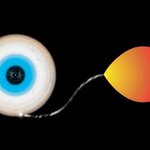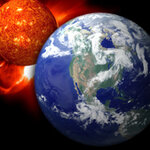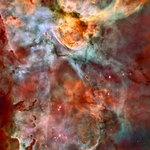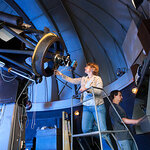Space

Some of the only theories that deal with black holes and stars is that sometimes stars can create black holes by implosion. This theory states that black holes have more to do with stars than originally thought. The Two sided black hole theory states that there are , obviously two sides of a black hole. One side does the pulling in of matter, the other expels it. The expelling side is what we would call a star, due to the fact the side that draws in matter, the other side of the hole has to expel it. In the process of the vacuum the matter is accelerated to a…

Astronomers have found more than 300 alien (extrasolar) worlds so far. Most of these are gas giants like Jupiter, and are either too hot (too close to their star) or too cold (too far away) to support life as we know it.
Sometime in the near future, however, astronomers will probably find one that's just right – a planet with a solid surface that's the right distance for a temperature that allows liquid water -- an essential ingredient in the recipe for life.
But the first picture of this world will be just a speck of light. How can we find out if it might have liquid water on its surface?…

http://www.coelumstream.com/ is broadcasting live images of galaxies, to be compared with reference images in search for supernovaes. A commentary is provided in Italian and English. Join NOW!
Below is a screenshot of what is being shown now.

This week's PhD Comic lists the 4 'research topics guaranteed to be picked up by the new media':
Chocolate
Robots
Unrealistic Sci-Fi gadgets
Experiments that might blow up the world
So far I'm at best 1 for 4, having covered Earth in peril in Jupiter Ignites! and in Secrets in the L4/L5 Gravity Wells. Which also happen to be most two most-trafficed articles. So clearly Jorge, the comic's author, is onto something.
With that in mind, my readers can expect a piece on space robots in the next few weeks, as well as an in-depth look at neat space gadgetry that may or may not only…

Pulsars are superdense neutron stars, the remnants left after massive stars have exploded as supernovae. Their powerful magnetic fields generate lighthouse-like beams of light and radio waves that sweep around as the star rotates. Most rotate a few to tens of times a second, slowing down over thousands of years.
Some, dubbed millisecond pulsars, rotate hundreds of times a second. Astronomers believe the fast rotation is caused by a companion star dumping material onto the neutron star and spinning it up. The material from the companion would form a flat, spinning disk around the neutron star…

Using ESO's Very Large Telescope, astronomers have succeeded in measuring the size of giant galaxy Messier 87 - or what they thought there should be. It turns out that its outer parts have been stripped away - and no one is yet sure how. To add to its woes, the galaxy also appears to be on a collision course with another giant galaxy in this dynamic cluster.
The new observations reveal that Messier 87’s halo of stars has been cut short, with a diameter of about a million light-years, significantly smaller than expected, despite being about three times the extent of the…

"We have the habit, as humans, of only thinking that what we see is real", began Neil Tyson. Our job as astronomers is to 'turn something invisible and make it real'. His premise: space weather is important to study, but scientists also have to step up their game in communicating why this is important.
Dr. Neil deGrasse Tyson spoke at the 3rd Space Weather Enterprise Forum today. As an astrophysicist and director of the Hayden Planetarium, part of his job is "when the universe flinches and the reporters come to knock on my door" it's "because there is a hunger" for science.…

Astronauts blazed through their third of five spacewalks Saturday as they continued servicing the Hubble Space Telescope, installing the new Cosmic Origins Spectrograph (COS) and repairing the main science camera of the Advanced Camera for Surveys (ACS) which has been disabled since February 2007. Initial tests verified that both instruments were alive and able to communicate with ground control.
(2007 photo: Cariana Nebula imaged with ACS and CTIO; credit: NASA, ESA, N. Smith, STScI, AURA, NOAO, NSF)After a nail-biting EVA 1 Thursday in which a stubborn bolt nearly derailed plans…

8 classrooms in 5 hours. 30 minutes per class. Grade levels ranging from kindergarten to 6th grade. Unscripted, 1 index card of talking points. When I compare 'Career Day' at my kids' elementary school with my Ph.D. defense, that dissertation committee seems the easier audience-- fewer questions outside of my field.
This blog serves me well for my K12 talks. Many of the concepts I work with here-- what it's like to be a working astronomer, what motivates me, what neat science stuff have I come across-- are perfect for talking to school kids. I used much of material here when I talked there.…

The Whole Earth Telescope (WET), a worldwide network of observatories coordinated by the University of Delaware, is synchronizing its lenses to provide round-the-clock coverage of a cooling star. As the star dims in the twilight of its life, scientists hope it will shed light on the workings of our own planet and other mysteries of the galaxy.
The dying star, a white dwarf identified as WDJ1524-0030, located in the constellation Ophiuchus in the southern sky, is losing its brightness as it cools, its nuclear fuel spent. It will be monitored continuously from May 15 to June 11 by WET, a global…